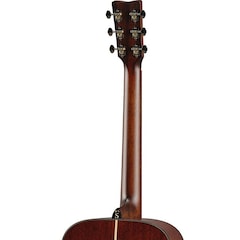Yamaha FS9 Acoustic Guitar. New Concert-Style Model Joins Lineup of Yamaha's Flagship Acoustic Guitars that Provide Expressiveness Ideal for Singer-Songwriters
Yamaha Corporation announces the release of its FS9 acoustic guitar.
FS9 R acoustic guitars
FS9 M acoustic guitars
Yamaha began sales of guitars in earnest with the release of its FG150 and FG180 acoustic guitars in 1966, and has since continued to expand its lineup to include everything from entry-level models to high-end models designed for professional musicians. Throughout its long history, the FG lineup of acoustic guitars has continued to exhibit quality improvements and technological innovation, leading to the release of the FG9 flagship model in April 2023. Since their initial release, these guitars have facilitated the musical expression of many players in a wide variety of situations.
Like the FG9, the new FS9 is a flagship model with an uncompromising design that strives to achieve expressiveness ideal for the singer-songwriter using an acoustic guitar as accompaniment. While the dreadnought-style design of the FG9 makes it suitable for powerful strumming, the FS9 features a compact, concert-style body that makes it perfect for fingerpicking. Top boards made from precious Adirondack spruce produce sound that achieves a balance of outstanding projection and striking clarity. With a thicker backboard than previous FS models, the body of the FS9 produces more powerful sound, offering expressiveness ideal for singer-songwriters. The 25-inch scale and slightly rounded V-shaped neck also offer exceptional playability. The characteristic design achieves a fusion of simplicity and flagship-model aesthetics that keeps the focus on the player onstage.
Key Features
1. New design offers balance of projection and clarity that supports player expression
FS9 top boards feature Adirondack spruce, a rare hardwood, and unique scalloped bracing designed by Yamaha's skilled luthiers through a series of trials and prototyping using cutting-edge acoustic and 3D structural measurement processes. The new design maintains structural strength while allowing the body to vibrate more efficiently, resulting in outstanding projection combined with the exceptional clarity of Yamaha acoustic guitars. The backboard is thicker than previous FS models, increasing its reflective properties to enhance the ability of the body to produce powerful sound.
The neck joint employs a bolt-on configuration that introduces a moderate amount of separation betwneen the neck and body, which more effectively transfers the energy of picking to the body of the guitar for greater volume. The design of the FS9 delivers sound that can accommodate songs that call for clear sound with detailed articulation, while also producing powerful, resonant sound during a climax.
2. New V-shaped neck offers exceptional playability

Exceptional playability is achieved by preserving the smaller body and shorter scale (25-inch) of the conventional concert-style guitar, while opting for a slightly rounded V-shaped neck that makes the neck easier to hold. This unique combination facilitates stress-free performance and ideal expressiveness.
3. Choose from two distinct sound profiles
Players can choose from two distinct sound profiles while still enjoying unique FS sound, thanks to the newly designed construction of the FS9, available in two models with differing back and side materials. The FS9 R uses Indian rosewood to produce beautifully resonant overtones with deep lows and crisp highs. The FS9 M uses African mahogany for sound with mid-focused warm tones.
FS9 R
FS9 M
4. Design that is simple yet refined, down to the finest detail
To ensure that the player is the star of the performance, the FS9 features a simple design that, when observed up-close, still offers a sense of flagship model refinement, down to the finest detail. The sound hole rosette and body purfling feature a rope-shaped inlay that has deep roots in Japanese culture, while the label seen through the sound hole is made from Japanese washi paper. Unique fingerboard inlays resemble traditional Japanese kumiki woodworking, resulting in a design from a Japanese manufacturer that is rich with embellishments rooted in Japanese culture.
Sound hole label made from Japanese washi paper
Rope-shaped inlay inspired by Japanese nawa rope
Fingerboard inlays that resemble traditional Japanese kumiki woodworking







